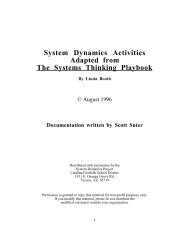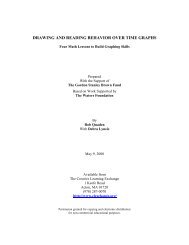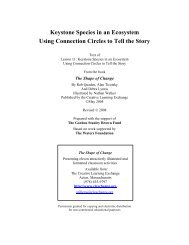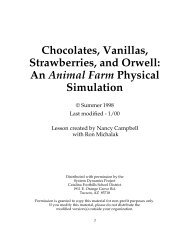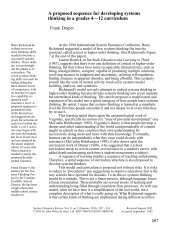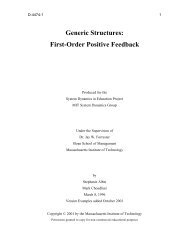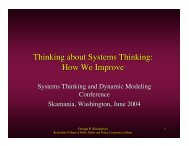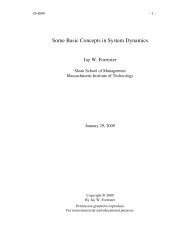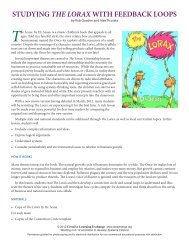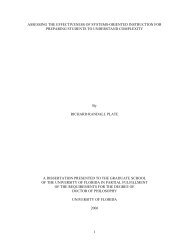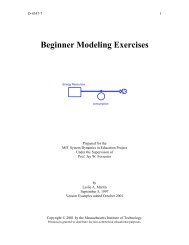Teaching System Dynamics to Teachers and Students in 8-12 ...
Teaching System Dynamics to Teachers and Students in 8-12 ...
Teaching System Dynamics to Teachers and Students in 8-12 ...
Create successful ePaper yourself
Turn your PDF publications into a flip-book with our unique Google optimized e-Paper software.
produce different graphs. Then a STELLA diagram is designed <strong>to</strong> def<strong>in</strong>e the given motion. This gives thestudents a visual description of the growth pattern. From the STELLA diagram the equation is developed.Then the usual exercises <strong>in</strong> equation manipulation follow. When the word problems arise, they are def<strong>in</strong>edus<strong>in</strong>g the equation approach <strong>and</strong>/or the STELLA diagram approach. F<strong>in</strong>ally, experiments are conducted ordata provided 50 students can determ<strong>in</strong>e an equation for a growth pattern where the numbers do not workout neatly. In this case data analysis (curve fitt<strong>in</strong>g) techniques are used. This strategy works well for thetraditional <strong>to</strong>pics <strong>in</strong> second year algebra—l<strong>in</strong>ear growth, quadratic growth, exponential growth, <strong>and</strong>oscillation. It has been evident that the <strong>in</strong>clusion of STELLA has provided students another way <strong>to</strong>underst<strong>and</strong> these growth patterns. In fact, when a reference <strong>to</strong> a previous growth pattern has been made,students <strong>in</strong>variably recall the STELLA diagram before the equation <strong>in</strong> order <strong>to</strong> describe it <strong>Students</strong> oftraditionally lesser ability have commented on the ease of underst<strong>and</strong><strong>in</strong>g the STELLA diagrams <strong>and</strong> havecompla<strong>in</strong>ed that they are not used more often. The <strong>in</strong>clusion of a more systemic approach <strong>and</strong> the use ofSTELLA diagrams <strong>in</strong> the def<strong>in</strong>ition of the traditional growth patterns has enhanced the learn<strong>in</strong>gsignificantly <strong>and</strong> required only about 15 class periods <strong>in</strong> the school year.Data was collected last year on the number of (non-honors) second year algebra students who elected <strong>to</strong>take another year of mathematics. The students from the traditional (non-honors) second year algebraclasses were compared <strong>to</strong> the students from the (non-honors) second year algebra class us<strong>in</strong>g STELLA.From the class us<strong>in</strong>g STELLA 78.9% of the students went on <strong>to</strong> take another math class, compared <strong>to</strong>60.6% for all the other non-honors second year algebra classes. (<strong>Students</strong> go<strong>in</strong>g on <strong>to</strong> take another mathclass were identified as those students who had successfully completed the first semester of pre-calculus ormath model<strong>in</strong>g the subsequent year. Note: Second year algebra is the term<strong>in</strong>al math class required forcollege admission.)It is apparent that many of the growth pattern approaches used <strong>in</strong> the second year algebra class could easilybe <strong>in</strong>corporated <strong>in</strong><strong>to</strong> a first year algebra class. If <strong>and</strong> when this occurs, the second year algebra classescould start <strong>to</strong> study some of the more sophisticated growth patterns fundamental <strong>in</strong> system dynamics.When this occurs more <strong>in</strong>terest<strong>in</strong>g <strong>and</strong> realistic problems could be addressed. Eventually, it would beuseful <strong>to</strong> <strong>in</strong>troduce the traditional growth patterns from a project perspective, similar <strong>to</strong> the work done byFrank Draper <strong>in</strong> 7th/8th grade science <strong>in</strong> the Catal<strong>in</strong>a Foothills School District <strong>in</strong> Tucson, Arizona. Oncethe second year algebra class has evolved <strong>to</strong> this po<strong>in</strong>t it could be counted as truly approach<strong>in</strong>g algebrafrom a system dynamics perspective. It is important, however, not <strong>to</strong> throw out the necessary skilldevelopment <strong>in</strong> the effort <strong>to</strong> br<strong>in</strong>g <strong>in</strong> the project approach. Consequently the process is still evolv<strong>in</strong>g. Asmore teachers become facile with the system approach <strong>to</strong> solv<strong>in</strong>g problems more material will be available<strong>to</strong> meet the needs of teachers <strong>in</strong> diverse environments.Ron Zaraza has used the STELLA II software <strong>in</strong> his physics classes. He has had his advanced placementphysics students design models <strong>to</strong> address the more difficult problems <strong>in</strong> the regular physics book so thatthose students who have difficulty underst<strong>and</strong><strong>in</strong>g the material/problems us<strong>in</strong>g a traditional approach mayhave an alternate way <strong>to</strong> view <strong>and</strong> <strong>in</strong>teract with the phenomenon under study. To prepare them for that useof STELLA II, the basics of STELLA II model<strong>in</strong>g as applied <strong>to</strong> motion were part of the lab activities <strong>in</strong> theadvanced placement course. STELLA II is also used <strong>in</strong> the course <strong>to</strong> present new ideas <strong>and</strong> <strong>to</strong> addressproblems which cannot be solved with the mathematics used <strong>in</strong> the course (pre-calculus level).In regular physics classes, STELLA II is used as part of a “cafeteria” approach <strong>to</strong> teach<strong>in</strong>g. Most <strong>to</strong>picsare taught several different ways <strong>to</strong> <strong>in</strong>crease the probability that one approach works with students.STELLA II, with its visual approach, is one more way <strong>to</strong> present ideas. It is not the primary approach, bu<strong>to</strong>ne of several which, when taken as a group, serve the needs of virtually all students.A quote attributed <strong>to</strong> Albert E<strong>in</strong>ste<strong>in</strong> epi<strong>to</strong>mizes the underly<strong>in</strong>g approach <strong>to</strong> system dynamics stressed bythis project, “Everyth<strong>in</strong>g should be as simple as possible, but no simpler.”8



